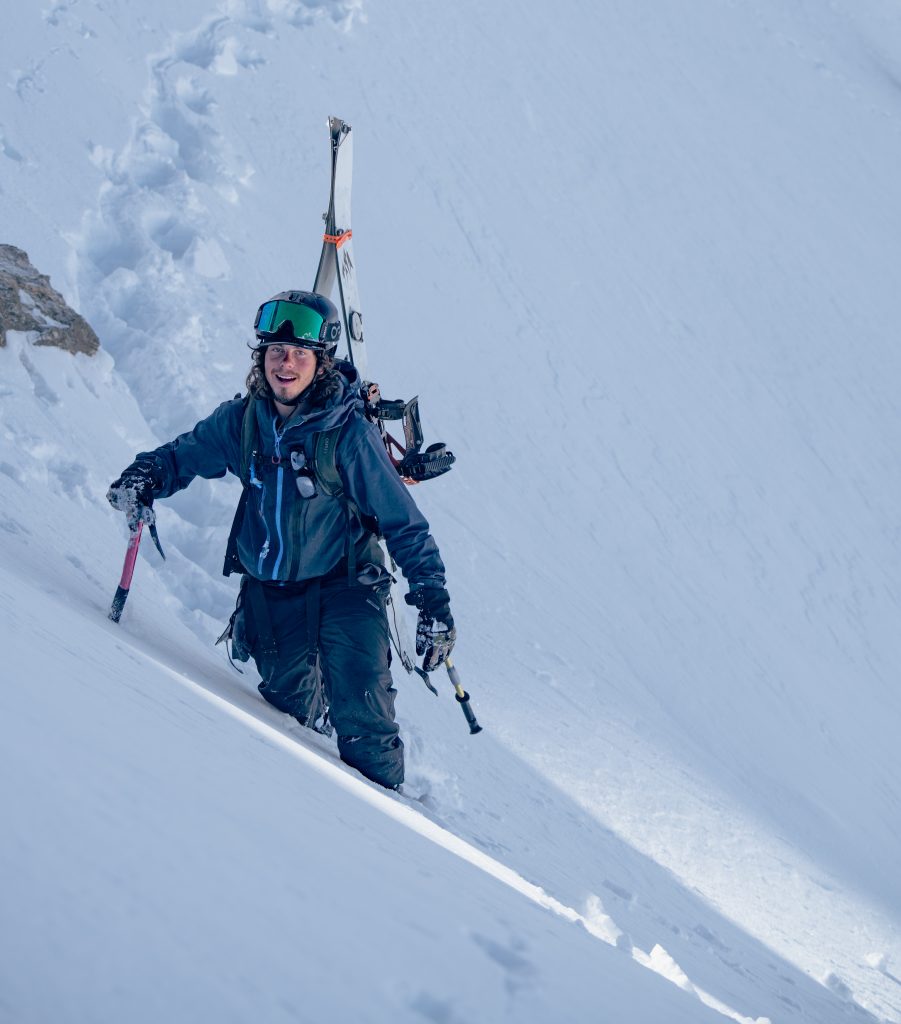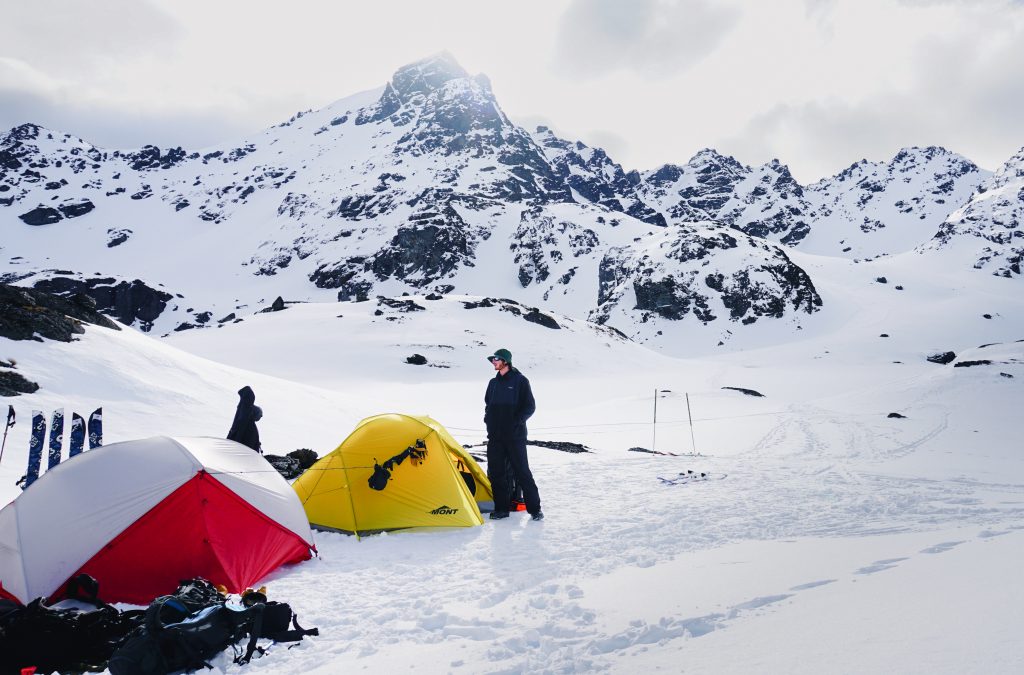A Queenstown-based film-maker wants us to think globally, shred locally.
Sage Kotsenburg once said, “there’s no blueprint to snowboarding, you know? You can really just make your own mark.” In 2014, Sage won the first-ever Olympic gold medal in men’s snowboard slopestyle, and his words still ring true for Ryan Quirke.

With the mountains up for their busiest winter season in years, Tāhuna Queenstown and Wānaka are abuzz with thrill-seekers, dream chasers and froth merchants. While most will be lining up like lemmings for the next chairlift, a group of locals are getting off the beaten tracks to make their own marks, and to share their adventures with others. They call the project Close to Home, and their aim is to promote human-powered exploration of our maunga with three key themes in mind: sustainability, safety and staying local. As well as shooting and releasing short-form content, this winter they’re launching a full-length film, also called Close to Home.

Ryan is the main lad behind the lens. Originally from Wellington, he’s a Queenstown-based producer, director and split boarder who has been running his own company for ten years. Recently, however, he decided he wanted to use his skills for the greater good. Along with featured riders like Chris Werme and Matias Jones, Ryan hopes to encourage viewers to explore the terrain around them in a sustainable way. As he explains, “we try to promote places that are easily accessible, but much less known about, places you might have to call a farmer for access to.”
The full film, which has been a year in the making, “aims to educate people on climate issues and making better decisions in the way they approach the mountains and the brands they spend their money on.” Both the short videos and the full Close to Home movie also have what Ryan calls a “mentoring” element when it comes to backcountry safety; expect a lot of transceiver check-ins, gear checks, scrutinising of snow stability and pit digging.
Speaking of snow stability, Close to Home started off as a winter endeavour, but when summer hit, the team were struck by how many of their friends were zooming off to the Northern Hemisphere to chase the snow. Were they tempted to join them? Yes, but they bucked the trend and kept their carbon footprints low, instead sticking around to “capitalise on the opportunities and what we have around us in the summertime, which fortunately is a lot of stuff.” With this in mind, the film opens with a short intro showcasing hobbies like surfing, trail running and hunting, highlighting all the good stoke-seeking going on year-round in the Otago and Southland regions. Then the pow adventures begin.

The group’s expedition to Lake Hope is the main focus of Close to Home. They planned to spend six days at the picturesque lake, the biggest in The Remarkables mountain range. The route in, via the South Branch of Wye Creek and Skingut Pass, features lush forests, cascading waterfalls, as well as spectacular views of the Whakatipu Basin and the backside of The Remarks. There’s also the nearby Two Mile Hut, a historic stone musterer’s hut built by the boundary keeper for Kawarau Falls Run more than a hundred years ago. Half of the crew hiked in while the others had to heli up with their equipment, a sometimes-necessary evil – it’s just not always possible for the crew to cart all the gear in themselves. Ryan alone needs to bring a laptop, hard drive and power so he can work in the downtime, sorting footage and editing. Still, better than racking up emissions on a long-haul flight.
The trip, their first into Lake Hope, wasn’t without its challenges. For one, the initially-bluebird weather packed in after three days, and the crew had to make the decision to get out and head back early via Two Mile Hut. And for Ryan, there was also the juggle of taking part in the fun while being in charge of the camera. “Some of the bigger lines we wanted to do, I wanted to do them too, and so the question arose, how do we film the filmer? A lot of the footage of me was going up with the drone and self-shooting it by myself – so putting the drone up, locking up the controller, essentially so it doesn’t push buttons in my bag. Then also setting up my GoPro, doing the line, and then having to deal with bringing the drone back down before immediately having to shoot my three other friends who are also coming down. It can get pretty full on,” Ryan explains.
The hardest part of this kind of work, though, can be bearing witness to some of the consequences of climate change. Another filming destination, Somnus Couloir, is known as a year-round skiing and riding spot, thanks to a lack of sun and a thermal layer of snow. Accessed via the north branch of the Routeburn Track, it’s bloody beautiful, but you have to work, or walk, for your lines. On one trip to the couloir towards the end of the year, the team found they could barely ride it due to high rainfall earlier in the season. According to Ryan, “the snow base builds up and then over the summertime it melts less than it’s built up, so over the course of however long that couloir has been there, it’s built up this base of metres and metres of snow – almost like a glacier. You’ve always been able to ride in January. But we went there in, probably, November and it was borderline unrideable because of how much the snow had started to melt.”
What they saw at Somnus Couloir is all too familiar for groups like Protect Our Winters Aotearoa, who work to educate the public on the issues of climate change and to protect the alpine environment from its damaging effects. They report Aotearoa New Zealand’s alps have lost a third of their ice snowpack since 1977.

For Ryan, one goal of the Close to Home film is to remind audiences “not to take for granted what we have right in front of us year-round. If you look at the positives, there’s a hell of a lot of good stuff right here in front of you, and you can really live an incredible lifestyle in a spot like this.” He hopes to nurture a community committed to sustainable, safe adventure in their own backyard, because what’s good for the environment is good for us.
As Ryan said after a big day out in the hills above Queenstown last year, “today was one of those days that makes me super grateful that no matter what stressful shit is happening in the real world, I have this life in the mountains to escape to.” The message of Close to Home is, let’s make sure he always does, and we do too.
Jessica Allen

